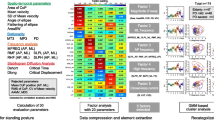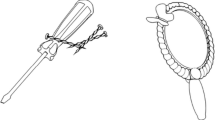Abstract
It was earlier shown that ultraslow tilts of the support under quiet standing conditions evoke an unusual response reflecting the operation of compensatory mechanisms: postural sway is a superposition of postural oscillations typical of quiet standing and greater, slower inclinations of the body caused by the tilt. This may be explained by the presence of two hierarchical levels of upright posture control: real-time control compensates for small deviations of the body from the reference posture prescribed by presetting control. Mathematical simulation methods have been used to study the mechanisms of reference posture control. The results are compared with available experimental data. It is demonstrated that the reference posture can be corrected according to the gravitational vertical with the use of a kinesthetic reference alone. It is hypothesized that, when correcting the reference posture, the nervous system “assumes” the support to be immobile. The afferent input from sole pressure receptors is an important factor in reference posture correction. The advantages of the putative two-level control over control based on an explicit internal model are discussed.
Similar content being viewed by others
References
Fitzpatrick, R.C. and McCloskey, D.I., Proprioceptive, Visual And Vestibular Thresholds for the Perception of Sway during Standing in Humans, J. Physiol., 1994, vol. 478, no. 1, p. 173.
Gurfinkel’, V.S., Kots, Ya.M. and Shik, M.L., Regulyatsiya pozy cheloveka (Human Posture Control), M.: Nauka, 1965.
Gurfinkel’, V.S., Lipshits, M.I., and Popov, K.E., Kinesthetic Sensitivity Thresholds in an Upright Posture, Fiziol. Chel., 1982, vol. 8, no. 6, p. 931.
Gurfinkel’, V.S., Ivanenko, Yu.P., Levik, Yu.S., and Babakova, I.A., Kinesthetic Reference for Human Orthograde Posture, Neuroscience, 1995, vol. 68, no. 1, p. 229.
Morasso, P. and Schieppati, M., Can Muscle Stiffness Alone Stabilize Upright Standing?, J. Neurophysiol., 1999, vol. 82, p. 1622.
Fel’dman, A.G., Tsentral’nye i reflektornye mekhanizmy upravleniya (Central and Reflex Control Mechanisms), Moscow: Nauka, 1979.
Fradkov, A.L., Adaptivnoe upravlenie v slozhnykh sistemakh (Adaptive Control in Complex Systems), Moscow: Nauka, 1990.
Terekhov, A.V., A Mathematical Model of Human Upright Posture Stabilization during Slow Perturbations of the Support, in Matematicheskoe modelirovanie dvizhenii cheloveka v norme i pri nekotorykh vidakh patologii (Mathematical Simulation of Movements in Healthy Humans and in Some Pathologies), Novozhilov, I.V. and Kruchinin, P.A., Eds., Moscow: Mosk. Gos. Univ., 2005.
Begun, P.I. and Shukeilo, Yu.A., Biomekhanika (Biomechanics), St. Petersburg: Politekhnika, 2000.
Winter, D.A., Patla, A.E., Prince, F., et al., Stiffness Control of Balance in Quiet Standing, J. Neurophysiol., 1998, vol. 80, p. 1211.
Gurfinkel’, V.S., Lipshits, M.I., and Popov, K.E., Is the Stretch Reflex the Main Mechanism of Posture Control in Humans?, Biofizika, 1974, vol. 19, no. 4, p. 744.
Micheaul, P., Kron, A., and Bourassa, P., Evaluation of the Lambda Model for Human Postural Control during Ankle Strategy, Biol. Cybern., 2003, vol. 89, p. 227.
Fitzpatrick, R.C., Taylor, J.L., and McCloskey, D.I., Ankle Stiffness of Standing Humans in Response to Imperceptible Perturbation: Reflex and Task-Dependent Components, J. Physiol., 1992, vol. 454, no. 1, p. 533.
Kavounoudias, A., Roll, R., and Roll, J.P., Foot Sole and Ankle Muscle Inputs Contribute Jointly to Human Erect Posture Regulation, J. Physiol., 2001, vol. 532, no. 3, p. 869.
Kiemell, T., Oie, K.S., and Jeka, J.J., Multisensory Fusion and the Stochastic Structure of Postural Sway, Biol. Cybern., 2002, vol. 87, p. 262.
Kluzik, J., Horak, F.B., and Peterka, R.J., Differences in Preferred Reference Frames for Postural Orientation Shown by After-effects of Stance on an Inclined Surface, Exp. Brain. Res., 2005, vol. 162, p. 474.
Maurer, C., Schweigart, G., and Mergner, T., Pronounced Overestimation of Support Surface Tilt during Stance, Exp. Brain. Res., 2006, vol. 168, nos. 1–2, p. 41.
Zatsiorsky, V.M. and Duarte, M., Instant Equilibrium Point and Its Migration in Standing Task: Rambling and Trembling Components of Stabilogram, Motor Control, 1999, vol. 3, p. 28.
Lee, D.N. and Lishman, J.R., Visual Proprioceptive Control of Stance, J. Hum. Mov. Stud., 1975, vol. 1, p. 87.
Levik, Yu.S., Shlykov, V.Yu., Gurfinkel’, V.S., and Ivanenko, Yu.P., Eye Movements Induced by Changes in the Internal Representation of Body Posture, Fiziol. Chel., 2005, vol. 31, no. 5, p. 68 [Hum. Physiol. (Engl. Transl), 2005, vol. 31, no. 5, p. 554].
Author information
Authors and Affiliations
Additional information
Original Russian Text © A.V. Terekhov, Yu.S. Levik, I.A. Solopova, 2007, published in Fiziologiya Cheloveka, 2007, Vol. 33, No. 3, pp. 40–47.
Rights and permissions
About this article
Cite this article
Terekhov, A.V., Levik, Y.S. & Solopova, I.A. Mechanisms of reference posture correction in the system of upright posture control. Hum Physiol 33, 289–295 (2007). https://doi.org/10.1134/S036211970703005X
Received:
Issue Date:
DOI: https://doi.org/10.1134/S036211970703005X




